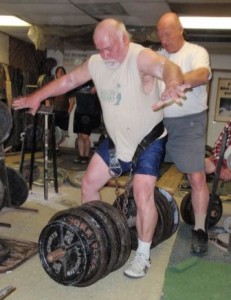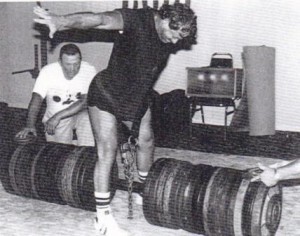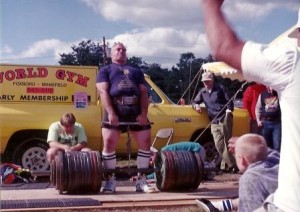The Hip Lift
By Eric Todd
This is the third and final installment of articles regarding the lifts that will be contested at the Heavy Lift Championship. This particular article is about the hip lift, which will be the last lift contested and the one in which the highest poundages should be attained. Not unlike the other heavy lifts (including those that are not being contested-the harness lift and the back lift), the hip lift was a favorite of many of the old timers as it allows you to lift mostrous poundages. It is the leverages and the short range of motion that allows that. There are very few lifts out there where lifters can legitimately make the claim of having lifted a ton, but for some lifters, it is true in the hip lift.
The most ever lifted in the Hip lift was 2525 by John Carter who lifted it at the 1994 Heavy Lift Championship meet in Columbia, MO. Big Frank Ciavattone was nipping on his heels with a 2515 pound effort at a record day in ‘07. All the overall records in the 85 kilo to 125+ are at or above a ton. Big numbers can be lifted in this discipline, and I do not imagine this year’s Heavy Lift Championship will be any different.
The first time I did any of the heavy lifts, I did the hand and thigh and the hip lift at the Deanna Springs memorial in 2002. The difference between my results in the two lifts was negligible, and I just figured I was good at the hand and thigh, but not the hip. My results for years were about the same. It was until I got a heavy bar and hip belt of my own that I was able to tweak my technique and make noticeable results in the hip lift. Now the difference in my PRs between the lifts is 760 pounds.
I will tell you the thing I learned that made the biggest difference in a moment. First I want to get into the generalities of the lift. The rules as stated in the USAWA Official Rulebook , 10th edition are as follows:
A Heavy Lift Bar is used in this lift. A hip belt is also used, which fits over the hips and around the waist. An adjustable chain and hook is attached to the hip belt so it may be attached to the Heavy Lift Bar. The width of the hip belt must not exceed 4 inches. Hands may be used as support on the legs during the lift, but must be free of contact at the completion of the lift. The lifter assumes a position in which the lifter is straddling the Heavy Lift Bar. Width of feet placement is optional, but the feet must be parallel and in line with the torso. The feet must not move during the lift, but the heels and toes may rise. The lifter may adjust the chain length to his/her preference prior to the lift. The lift begins at the lifter’s discretion. The lifter is allowed one test lift to check the balance of the weight and to make adjustments to the chain length. The lifter will stand and lift the weights from the platform. The shoulders and torso do not have to be upright upon the finish of the lift. The legs must straighten, but the knees do not need to be locked. Once the weight is motionless, the hands free from the body, and the plates on both ends of the bar are off the platform at the same time, an official will give a command to end the lift.
The execution of this lift is rather simple. Place the hip belt around your waist. Straddle the big bar. I always sit on the weights to attach my chain. Run the chain through the designated space in the bar, then back up to clasp to the other end of the hip belt. Connect it at a length where you have some flex in your legs, but not a boat load. You will want to start with your feet placed such that your chain is perpendicular to the floor. Start with your hands on your thighs, and drive up through your feet. When both ends of the weight leave the floor simultaneously, remove your hands from your thighs. At that point, you will get a “down” command from your official.
Now, the key in my eyes for this lift is the belt placement. When i started off, I would put the hip belt about where my powerlifting belt sat, around my core. So when I executed the lift, the belt was pressing against by lower back. The more I practiced the lift, the more I realized this placement was wrong. It is called a hip lift for a reason. Push that hip belt down on your hips. Anymore it is not on my low back at all, and that has helped my results tremendously.
So, there you have it. Go find a big bar and a hip belt and give it a whirl. You will lift more weight than you ever thought possible (unless you have done a back lift or a harness lift, then maybe you have lifted more). This will be the last lift contested at the Heavy Lift Championship. It has more than once been the deciding factor in who the overall champion would be. Now you have a primer for all three lifts. So, time to get training and get that entry into the mail. I will be waiting…
A video of Steve Schmidt hip lifting:


